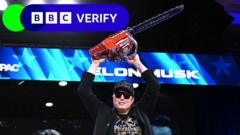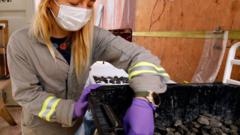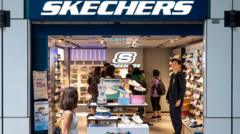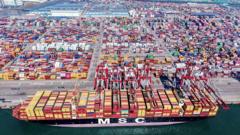As companies like Unitree and Tesla push boundaries, the global landscape for humanoid robotics shows signs of a fascinating race.
The Race for Humanoid Robots: Who's Leading?
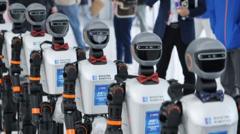
The Race for Humanoid Robots: Who's Leading?
Exploring the competition in humanoid robot development amid technological challenges and investment trends.
In the bustling atmosphere of Hanover, Germany, the Hannover Messe plays host to the revolutionary Unitree G1, a humanoid robot drawing attention for its remarkable agility and affordability. Standing at 4'3" (130cm), the G1, controlled by Pedro Zheng, the company's sales manager, boasts movements so fluid that its viral videos of dancing and martial arts captivate the audience. As visitors flock to engage with the G1, its human-like appearance fosters a sense of connection that sets it apart from other mechanized counterparts.
The quest for humanoid robotics exists within a larger landscape, currently dominated by the promise of an efficient, tireless workforce that can operate without the limitations of human employees. Yet, integrating such robots into unpredictable environments like homes or restaurants poses significant challenges, particularly concerning strength and safety. Today's advanced robotic arms, often employed in controlled environments such as factories, underline the hurdles yet to be overcome by humanoid forms.
While robotic technology continues to evolve, artificial intelligence still grapples with complex logic and reasoning, according to a spokesperson from Unitree, highlighting that even innovative models like the G1 are primarily tailored for research institutions and tech developers. Many firms are directing their efforts toward production lines, with notable ventures from Elon Musk's Tesla, which plans to manufacture "several thousand" humanoid Optimus robots.
Tracking the competitive field, research analyst Thomas Andersson identifies around 49 companies venturing into humanoid robotics, with the potential to surpass 100 by including vehicles with robotic arms. A critical observation lies in the evolving dominance of Chinese firms in this market, capitalizing on a rich ecosystem for research and development supported by local government initiatives.
As assessments reveal that nearly 60% of funding for humanoid robots originates from Asia, comparisons to American and European developers reveal stark contrasts in operations and manufacturing. Bren Pierce, a robotics entrepreneur based in Bristol, acknowledges that constructing robots in Asia mitigate challenges stemming from international supply chains. His latest creation, the KR1, designed for warehouse environments without legs, exemplifies this strategy.
Pierce emphasizes a straightforward approach with mass-produced components that keep costs low while ensuring his robots are user-friendly for warehouse employees. The KR1 is set for pilot testing this year, promising ease of installation and human-robot collaboration through simple programming techniques.
Despite ambitious visions of humanoid robots aiding in everyday household tasks, industry experts caution against overestimating the timeline for such capabilities, with estimates pushing ambitions for widespread use at least a decade out. With a rapidly evolving industry, the culmination of these efforts could indeed reshape the future of human-robot relationships, making the race toward effective humanoid robotics one to watch closely.
The quest for humanoid robotics exists within a larger landscape, currently dominated by the promise of an efficient, tireless workforce that can operate without the limitations of human employees. Yet, integrating such robots into unpredictable environments like homes or restaurants poses significant challenges, particularly concerning strength and safety. Today's advanced robotic arms, often employed in controlled environments such as factories, underline the hurdles yet to be overcome by humanoid forms.
While robotic technology continues to evolve, artificial intelligence still grapples with complex logic and reasoning, according to a spokesperson from Unitree, highlighting that even innovative models like the G1 are primarily tailored for research institutions and tech developers. Many firms are directing their efforts toward production lines, with notable ventures from Elon Musk's Tesla, which plans to manufacture "several thousand" humanoid Optimus robots.
Tracking the competitive field, research analyst Thomas Andersson identifies around 49 companies venturing into humanoid robotics, with the potential to surpass 100 by including vehicles with robotic arms. A critical observation lies in the evolving dominance of Chinese firms in this market, capitalizing on a rich ecosystem for research and development supported by local government initiatives.
As assessments reveal that nearly 60% of funding for humanoid robots originates from Asia, comparisons to American and European developers reveal stark contrasts in operations and manufacturing. Bren Pierce, a robotics entrepreneur based in Bristol, acknowledges that constructing robots in Asia mitigate challenges stemming from international supply chains. His latest creation, the KR1, designed for warehouse environments without legs, exemplifies this strategy.
Pierce emphasizes a straightforward approach with mass-produced components that keep costs low while ensuring his robots are user-friendly for warehouse employees. The KR1 is set for pilot testing this year, promising ease of installation and human-robot collaboration through simple programming techniques.
Despite ambitious visions of humanoid robots aiding in everyday household tasks, industry experts caution against overestimating the timeline for such capabilities, with estimates pushing ambitions for widespread use at least a decade out. With a rapidly evolving industry, the culmination of these efforts could indeed reshape the future of human-robot relationships, making the race toward effective humanoid robotics one to watch closely.





